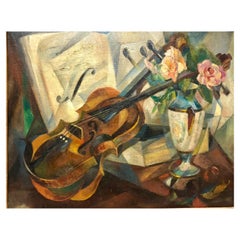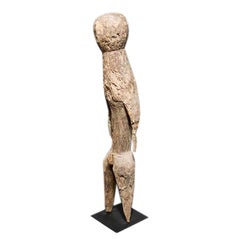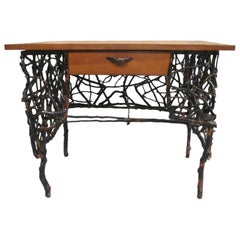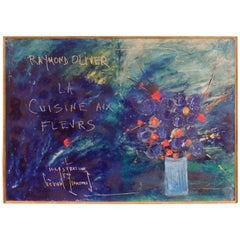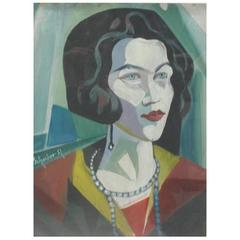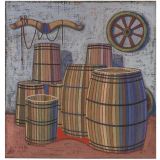Thomas Gallery Ltd Folk Art
to
1
7
7
2
2
1
1
5
1
4
3
3
3
2
1
3
3
2
1
1
7
7
7
1
1
1
Cubist Still Life "Violin" by Early Modernist, Agnes Weinrich, Signed Dated 1922
By Agnes Weinrich
Located in New York, NY
Still life painting (Violin, Flowers), Oil on canvas, by Agnes Weinrich, Signed and dated "22", Unframed: 20" x 16", Framed 27.5 x 23".
Agnes Weinrich (1873-1946) was an early female, American modernist artist at a time when there was little interest in Modern Art in the USA and when few women were artists. She was a ground breaker in modern art. The painting shown is an important example of her mature phase of her work.
A biography from Wiki-pedia follows:
Agnes Weinrich (1873–1946) was one of the first American artists to make works of art that were modernist, abstract, and influenced by the Cubist style. She was also an energetic and effective proponent of modernist art in America, joining with like-minded others to promote experimentation as an alternative to the generally conservative art of their time.
Early years[edit]
Agnes Weinrich was born in 1873 on a prosperous farm in south east Iowa. Both her father and mother were German immigrants and German was the language spoken at home. Following her mother's death in 1879 she was raised by her father, Christian Weinrich. In 1894, at the age of 59, he retired from farming and moved his household, including his three youngest children—Christian Jr. (24), Agnes (21), and Lena (17), to nearby Burlington, Iowa, where Agnes attended the Burlington Collegiate Institute from which she graduated in 1897.[1][2][3] Christian took Agnes and Lena with him on a trip to Germany in 1899 to reestablish links with their German relatives. When he returned home later that year, he left the two women in Berlin with some of these relatives, and when, soon after his return, he died, they inherited sufficient wealth to live independently for the rest of their lives.
Either before or during their trip to Germany Lena had decided to become a musician and while in Berlin studied piano at the Stern Conservatory. On her part, Agnes had determined to be an artist and began studies toward that end at the same time.[1][4] In 1904 the two returned from Berlin and settled for two years in Springfield, Illinois, where Lena taught piano in public schools and Agnes painted in a rented studio. At this time Lena changed her name to Helen. In 1905 they moved to Chicago where Agnes studied at the School of the Art Institute of Chicago under John Vanderpoel, Nellie Walker, and others.[1]
In 1909 Agnes and Helen returned to Berlin and traveled from there to Munich, where Agnes studied briefly under Julius Exter, and on to Rome, Florence, and Venice before returning to Chicago.[5] They traveled to Europe for the third, and last, time in 1913, spending a year in Paris. There, they made friends with American artists and musicians who had gathered there around the local art scene. Throughout this period, the work Agnes produced was skillful but unoriginal—drawings, etching, and paintings in the dominant academic and impressionist styles.[1]
On her return from Europe in 1914, she continued to study art, during the warm months of the year in Provincetown, Massachusetts,[1] where she was a member of the Provincetown Printers art colony in Massachusetts,[6] and during the colder ones in New York City. In Provincetown she attended classes at Charles Hawthorne's Cape Cod School of Art and in New York, the Art Students League.[1]
Drawing of an old woman by Agnes Weinrich, graphite on paper, 11.5 x 7.5 inches.
Hawthorne and other artists established the Provincetown Art Association in 1914 and held the first of many juried exhibitions the following year. Weinrich contributed nine pictures to this show, all of them representational and somewhat conservative in style.[1]
A pencil sketch made about 1915 shows a figure, probably one of the Portuguese women of Provincetown. Weinrich was a metculous draftsperson and this drawing is typical of the work she did in the academic style between 1914 and 1920. She also produced works more akin to the Impressionist favored by Hawthorne and many of his students. When in 1917 Weinrich showed paintings in a New York women's club, the MacDowell Club, the art critic for the Brooklyn Daily Eagle said they showed a "strong note of impressionism."[7]
Broken Fence by Agnes Weinrich, a white-line woodblock made on or before 1917; at left: the woodblock itself; at right: a print pulled from the woodblook.
In 1916 Weinrich joined a group of printmakers which had begun using the white-line technique pioneered by Provincetown artist B.J.O. Nordfelt. She and the others in the group, including Blanche Lazzell, Ethel Mars and Edna Boies Hopkins, worked together, exchanging ideas and solving problems.[1][8] A year later Weinrich showed one of her first white-line prints at an exhibition held by the Pennsylvania Academy of Fine Arts in Philadelphia.[9]
Broken Fence, in its two states—the print and the woodblock from which she made it—show Weinrich to be moving away from realistic presentation, towards a style, which, while neither abstract, nor Cubist, brings the viewer's attention to the flat surface plane of the work with its juxtaposed shapes and blocks of contrasting colors.
Cows Grazing in the Dunes near Provincetown by Agnes Weinrich, white-line woodcut, 10 x 10 1/2 inches
When in 1920 the informal white-line printmakers' group organized its own exhibition, Weinrich showed a dozen works, including one called Cows Grazing in the Dunes near Provincetown. This print shows greater tendency to abstraction than eitherBroken Fence or the prints made by other Provincetown artists of the time. The cows and dunes are recognizable but not presented realistically. The white lines serve to emphasize the blocks of muted colors which are the print's main pictorial elements. Weinrich uses the texture of the wood surface to call attention to the two-dimensional plane—the paper on which she made the print—in contrast with the implicit depth of foreground and background of cows, dunes, and sky. While the work is not Cubist, it has a proto-Cubist feel in a way that is similar to some of the more abstract paintings of Paul Cézanne.[10]
By 1919 or 1920, while still spending winters in Manhattan and summers on Cape Cod, the sisters came to consider Provincetown their formal place of residence.[1][11][12][13] By that time they had also met the painter, Karl Knaths. Like themselves a Midwesterner of German origin who had grown up in a household where German was spoken, he settled in Provincetown in 1919. Agnes and Knaths shared artistic leanings and mutually influenced each other's increasing use of abstraction in their work.[1][14]
The sisters and Knaths became close companions. In 1922 Knaths married Helen and moved into the house which the sisters had rented. He was then 31, Helen 46, and Agnes 49 years old. When, two years later, the three decided to become year-round residents of Provincetown, Agnes and Helen used a part of their inheritance to buy land and materials for constructing a house and outbuildings for the three of them to share. Knaths himself acquired disused structures nearby as sources of lumber and, having once been employed as a set building for a theater company, he was able to build their new home.[15]
Weinrich was somewhat in advance of Knaths in adopting a modernist style. She had seen avant-garde art while in Paris and met American artists who had begun to appreciate it. On her return to the United States she continued to discuss new theories and techniques with artists in New York and Provincetown, some of whom she had met in Paris. This loosely-knit group influenced one another as their individual styles evolved. In addition to Blance Lazzell, already mentioned, the group included Maude Squires, William Zorach, Oliver Chaffee, and Ambrose Webster. Some of them, including Lazzell and Flora Schofield had studied with influential modernists in Paris and most had read and discussed the influential Cubist and Futurist writings of Albert Gleizes and Gino Severini.[16][17]
Mature style[edit]
Woman with Flowers by Agnes Weinrich, circa 1920, oil on canvas, 34 x 30 1/4 inches, exhibited at the Provincetown Art Association exhibition of 1920, made available courtesy of the Association.
Two of Weinrich's paintings, both produced about 1920, mark the emergence of her mature style. The first, Woman With Flowers, is similar to one by the French artist, Jean Metzinger called Le goûter (Tea Time) (1911).[18]
Red Houses by Agnes Weinrich, circa 1921, oil on canvas on board, 24.25 x 25.5 inches; exhibited "Red Houses" at Fifth Annual Exhibition of the Society of Independent Artists.
Like much of Metzinger's work, Le goûter was discussed in books and journals of the time—including one called Cubism co-authored by Metzinger himself.[19] Because the group with which Weinrich associated read about and discussed avant-garde art in general and Cubism in particular, it is reasonably likely that Weinrich was familiar with Metzinger's work before she began her own.
The second painting, Red Houses, bears general similarity to landscapes by Cézanne and Braque. Both paintings are Cubist in style. However, with them Weinrich did not announce an abrupt conversion to Cubism, but rather marked a turning toward greater experimentation. In her later work she would not adopt a single style or stylistic tendency, but would produce both representative pictures and ones that were entirely abstract, always showing a strong sense of the two-dimensional plane of the picture's surface. After she made these two paintings neither her subject matter nor the media she used would dramatically change. She continued to employ subjects available to her in her Provincetown studio and the surrounding area to produce still lifes, village and pastoral scenes, portraits, and abstractions in oil on canvas and board; watercolor, pastel, crayon and graphite on paper; and woodblock prints.[20]
Possessing an outgoing and engaging personality and an active, vigorous approach to life, Weinrich promoted her own work while also helping Karl Knaths to develop relationships with potential patrons, gallery owners, and people responsible for organizing exhibitions. With him, she put herself in the forefront of an informal movement toward experimentation in American art. Since, because of her independent means, she was not constrained to make her living by selling art, she was free to use exhibitions and her many contacts with artists and collectors to advance appreciation and understanding of works which did not conform to the still-conservative norm of the 1920s and 1930s.[1][21][22]
Early in the 1920s, critics began to take notice of her work, recognizing her departure from the realism then prevailing in galleries and exhibitions. Paintings that she showed in 1922 drew the somewhat dry characterization of "individualistic.",[23] and in 1923 her work drew praise from a critic as "abstract, but at the same time not without emotion."[24]
In 1925 Weinrich became a founding member of the New York Society of Women Artists. Other Provincetown members included Blanche Lazzell, Ellen Ravenscroft, Lucy L'Engle, and Marguerite Zorach. The membership was limited to 30 painters and sculptors all of whom could participate in the group's exhibitions, each getting the same space.[23][25][26] The group provided a platform for their members to distinguish themselves from the genteel and traditionalist art that women artists were at that time expected to show[27] and, by the account of a few critics, it appears their exhibitions achieved this goal.[1][28][29][30]
In 1926 Weinrich joined with Knaths and other local artists in a rebellion against the "traditional" group that had dominated the Provincetown Art Association. For the next decade, 1927 through 1937, the association would mount two separate annual exhibitions, the one conservative in orientation and the other experimental, or, as it was said, radical.[31][32] Both Weinrich and Knaths participated on the jury that selected works for the first modernist exhibition.[11]
Still Life by Agnes Weinrich, circa 1926, oil on canvas, 17 x 22 inches. Permission to use granted by Christine M. McCarthy, Executive Director, Provincetown Art Association and Museum. The painting was the gift of Warren Cresswell.
Weinrich's painting, Still Life, made about 1926, may have been shown in the 1927 show. Representative of some aspects of her mature style, it is modernist but does not show Cubist influence. The objects pictured are entirely recognizable, but treated abstractly. Although fore- and background are distinguishable, the objects, as colored forms, make an interesting and visually satisfying surface design.
In 1930 Weinrich put together a group show for modernists at the GRD Gallery in New York. The occasion was the first time a group of Provincetown artists exhibited together in New York. For it she selected works by Knaths, Charles Demuth, Oliver Chaffee, Margarite and William Zorach, Jack Tworkov, Janice Biala, Niles Spencer, E. Ambrose Webster, and others.[1][23]
Later years[edit]
Weinrich turned 60 on July 16, 1933. Although she had led a full and productive life devoted to development of her own art and to the advancement of modernism in art, she did not cease to work toward both objectives. She continued to work in oil on canvas and board, pastel and crayon on paper, and woodblock printing. Her output continued to vary in subject matter and treatment. For example, Still Life with Leaves, circa 1930 (oil on canvas, 18 x 24 inches) contains panels of contrasting colors with outlining similar to Knaths's style. Movement in C Minor, circa 1932 (oil on board, 9 x 12 inches) is entirely abstract. It too relates to Knaths's work, both in treatment (again, outlined panels of contrasting colors) and in its apparent relationship to music, something in which Knaths was also interested. Fish Shacks...
Category
Early 20th Century American Modern Contemporary Art
Materials
Paint, Canvas
Carved Aftican Wood Sculpture from Togo
Located in New York, NY
Elegant, carved wood sculpture representing the human figure from Togo, Africa.
A large, dramatic piece for a tribal art collection and creating a rare, unique and special presence.
Category
Antique 19th Century Togolese Primitive Sculptures
Materials
Wood
Rare and Unique Modern Craftsman / Adirondack Twig Writing Desk
Located in New York, NY
A rare, unique neo-primitive /modern craftsman desk attributed to Lee Fountain (1869-1941) and composed of a base of interwoven twigs supporting a top in cherry. Drawer has a twig ha...
Category
Mid-20th Century American Adirondack Desks and Writing Tables
Materials
Twig, Cherry
Painting on Canvas, "La Cuisine Aux Fleurs" by Gerard Economos
By Gerard Economos 1
Located in New York, NY
Painting. Acrylic on canvas by Gerard Economos (French,1935-)
Gerard Economos is known for his passionate, intensely colored abstract compositions and large acrylic paintings that have been performed live in front of audiences in 12 countries. Economos has had over 88 events over the last 57 years and his work is now in collections in over 34 countries. He started Live Performances with the Greek avante-garde composer and architect, Iannis Xenakis during a Sound Festival; Subsequently he developed the "Une Musique a Voir" (A music to see) concept.
'La Cuisine aux Fleurs' (Cooking with Flowers) was a series of paintings initiated at the request of the renowned French Chef, Raymond Oliver in 1975 who wished to have his recipes illustrated. They have been rarely shown in public.
For an illustrated 15 page biography of Economos please contact Thomas Gallery Ltd...
Category
Mid-20th Century French Mid-Century Modern Paintings
Materials
Canvas, Acrylic
$3,000 Sale Price
40% Off
Portrait of an Elegant Woman, Signed Hugo Scheiber
By Hugó Scheiber
Located in New York, NY
Watercolor / painting signed Hugo Scheiber: Budapest (1873-1950).
Hugo Scheiber was born in Budapest in 1873. At the age of eight, he moved with his family from Budapest to Vienna. ...
Category
Mid-20th Century Hungarian Mid-Century Modern Paintings
Painting 'October in the Cantina' by Sergio Agostini, Italy, 1960
By Sergio Agostini
Located in New York, NY
"Ottobre in Cantina"
Painting, oil on canvas by Italian artist Sergio Agostini, Rome, 1960.
Signed on lower left with sticker from original exhibition at Galleria L'88 on Via M...
Category
Mid-20th Century Italian Modern Paintings
Materials
Canvas
Framed Collection of Mesoamerican Pre-Classic Period Sculptures & Arrow Heads
Located in New York, NY
Incredible collection of pre-columbian clay sculptures / figures / statues / pottery, mounted and framed. The pieces date from the pre-classic (Formative) period of Meso-American cul...
Category
Antique 15th Century and Earlier North American Pre-Columbian Figurative...
Materials
Clay, Precious Stone, Hardwood
Related Items
"Space bar" by WAS, Unique piece
Located in Marinha Grande, PT
"Space bar" by WAS
Airplane trolley turned into an unique Artwork
The trolley has been customized by the french artist WAS transforming it into a work...
Category
21st Century and Contemporary French Modern Painted Furniture
Materials
Metal, Aluminum
Decorative hand-woven bag/box from Panama, Sac-Bolso by Ethic&Tropic
By Ethic&Tropic
Located in Warsaw, PL
Decorative hand-woven bag from Panama, Sac-Bolso by Ethic&Tropic
Extraordinary art and decorative items, these masks come from the shamanic beliefs and rituals of indigenous Embera ...
Category
21st Century and Contemporary Panamanian Primitive Animal Sculptures
Materials
Cane
$273
H 4.73 in W 16.15 in D 5.91 in
Set of Six Early 20th Century Carved Wood Knobkerries, South Africa
Located in Point Richmond, CA
Six Knobkerries from South Africa
A group of six knobkerries from South Africa, mounted together on a wooden base. These were originally used as weapons during battle but have evolv...
Category
Early 20th Century South African Tribal Tribal Art
Materials
Wood
Gianfranco Asveri, Memorie 13062
By Gianfranco Asveri
Located in New York, NY
Memorie, #13062, by Italian artist Gianfranco Asveri mixed media on paper, gallery framed in white wood frame and under glass. Depicted are some of his favorite subjects, his mother, his dog, and his cat.
Live image measures 19.5 x 11.75 inches.
Gianfranco Asveri was born in Fiorenzuola D’Arda, Italy, in 1948. The artist lives and works at Gasperini on the hills between Parma and Piacenza with his beloved dogs.
He began to paint in 1969. His first work was merely figurative. In the 1980s he moved closer to the “Art Brut” style.
Renowned in Italy, Asveri has just finished a solo exhibition in Genoa at the Medioeval “Commenda” and will be presented in Paris next February during the Contemporary Art Fair in Port de Versailles.
Recently, the newspaper “Il Sole 24 Ore” (The Italian Economic newspaper) included Asveri among the artists to watch in terms of investment in the Italian Art Market.
An appreciable number of famous critics have written essays about his works: Paolo Bledinger, Luca Beatrice, Flaminio Gualdoni and Martina Corgnati.
Most Important Exhibitions:
2016
– Sogni dipinti, Galleria Rotaross, Novara.
– Lo sguardo nascosto, Galleria Biffi Arte, Piacenza.
2015
– Abracadabra, Galleria Leonardus, Sestri Levante...
Category
20th Century Italian Modern Paintings
Materials
Paint
Round Black Pedestal Dining Table, Sweden 1920
Located in Haddonfield, NJ
Early Swedish 20th Century Pedestal Dining Table in Black Paint.
This round table has beautiful Gustavian ribbed details with a border going around the table edge.
Category
Early 20th Century Swedish Gustavian Desks and Writing Tables
Materials
Pine
Françoise Gilot Lithograph 'Portrait of a Woman', 1951
By Françoise Gilot
Located in Barcelona, Barcelona
Françoise Gilot original lithograph 'Portrait of a Woman'.
From the poetry book "Pages d'Amour" by André VERDET, editions Raison d'être, 1951, printed by Mourlot in 366 copies.
Ma...
Category
Vintage 1950s French Mid-Century Modern Contemporary Art
Materials
Paper
$849 Sale Price
35% Off
H 18.31 in W 15.95 in D 0.79 in
Françoise Gilot Lithograph 'Portrait of a Woman', 1951
By Françoise Gilot
Located in Barcelona, Barcelona
Françoise Gilot original lithograph 'Portrait of a Woman'.
From the poetry book "Pages d'Amour" by André VERDET, editions Raison d'être, 1951, printed by Mourlot in 366 copies.
Ma...
Category
Vintage 1950s French Mid-Century Modern Contemporary Art
Materials
Paper
$1,040 Sale Price
30% Off
H 18.31 in W 15.95 in D 0.79 in
Signed and Dated 1935 Pastel Indian Chief
Located in Los Angeles, CA
This original framed pastel, hand-painted Indian chief is signed E. Summer 35 and is in wonderful condition.
Category
Vintage 1930s American Adam Style Paintings
Materials
Paint
19thc Original Salmon & Decorated Pennsylvania Blanket Chest
Located in Los Angeles, CA
This is a amazing untouched 19thc original paint decorated blanket chest is a small scale size.Wonderful as a coffee table or end of a bed for quilts & blankets.The condition is very...
Category
Antique 19th Century American Adirondack Blanket Chests
Materials
Pine
$1,516 Sale Price
38% Off
H 22 in W 38 in D 18 in
Large Modern Abstract Oil on Canvas "Sound Wave" by Carlo of Hollywood
By Carlo of Hollywood
Located in Buffalo, NY
Large modern abstract oil on canvas 'Sound Wave' by Carlo of Hollywood.
Category
Mid-20th Century American Mid-Century Modern Paintings
Materials
Canvas
$1,850
H 41.5 in W 61 in D 2 in
Antique Nupe Carved Wood Stool With Openwork Geometric Design, Niger Africa
Located in Point Richmond, CA
Well used and loved Nupe carved hardwood wood stool with four legs and central post, openwork geometric design, with stylized multiple dancing animal or lizard forms. Large conical ...
Category
Mid-20th Century Nigerien Tribal Tribal Art
Materials
Wood
$1,250
H 10 in W 13.5 in D 9.75 in
African Carved Wood "Tree of Life" Sculpture
Located in Chicago, IL
Beautiful, impressively sized and elaborately carved "Tree of Life" sculpture from Tanzania, Africa. These carvings are created from a single piece of wood and feature "Ujamma" or ...
Category
Antique 19th Century Tanzanian Tribal Tribal Art
Materials
Wood
